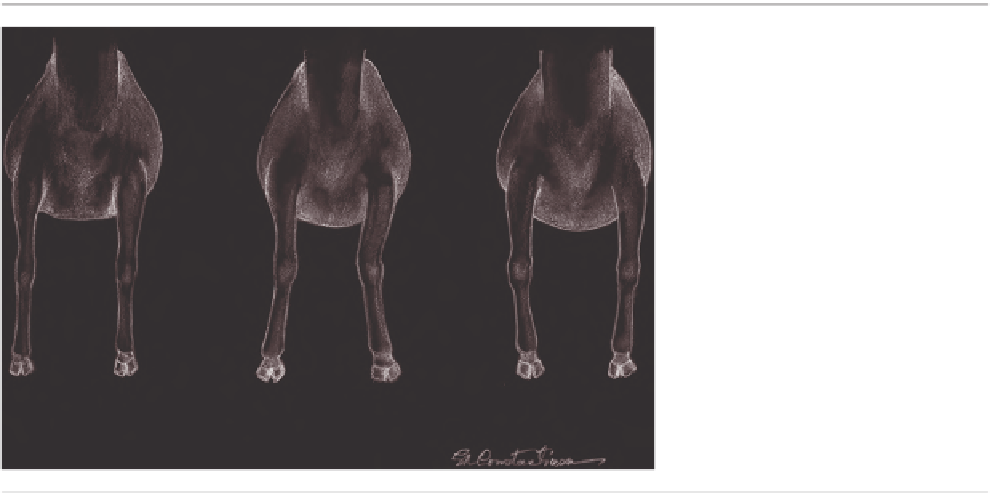Agriculture Reference
In-Depth Information
Ideal
Splay-footed
Pigeon-toed
Figure 5.8
Front-view leg
evaluation.
Mouth
Certain defects of the jaw should be observed. Different
conditions in jaw alignments are presented in Figure 5.9.
A mouth that is “ideal” in correct alignment has incisor
teeth that are fl ush with the pad of the upper jaw, providing
a true and even bite. The trait known as “parrot mouth”
is the condition of an undershot jaw (bottom jaw) or over-
bite (upper jaw). “Monkey mouth” is the condition of
an overshot jaw (bottom jaw) or underbite (upper jaw).
Both of these conditions lack coordination between the
teeth and the dental pad, thus can hinder prehension or
mastication.
muscling or thickness, boldness or spring of rib, and walk
with no apparent width between the legs when viewed
from either the front or the rear.
Front - View Evaluation
In viewing the animal from the front (Figure 5.8), the
correct (ideal) knee structure is straight up and down and
in-line with the forearm, the knee, the cannon, the pastern,
and the foot. “Splay-footed” is a common defect and is
associated with legs being knock-kneed—a defect in which
an animal possesses knees close together and the
lower forelimb and foot are wider than the knees, or
turned-out—a general term describing any combination of
knock - kneed and splay - footed. “ Pigeon - toed ” animals are
not common, but this trait is a serious defect because it is
often associated with other defects such as being wing-
shouldered—extreme width of the shoulders, often causing
the front legs to be bowed, base-narrow, or bowlegged.
Teats
Teat structure is of critical importance. Does should have
no more than two functional teats for each side of the udder
for meat-type goats and no more than one functional teat
for each side for dairy-type goats. It is important that the
structure of the udder is such that the offspring can nurse
unassisted or the milking machine fi ts properly. Animals
with pendulous udders, bulbous or over-sized teats should
be culled. Different teat structures are presented in Figure
5.10. One functional teat (with its milk channel) and one
nonfunctional teat, or two functional teats are acceptable
for meat goat type. Split teats (teats with two distinctly
separate milk channels) are not preferred. Cluster teats, a
grouping of three or more teats in which all, some, or none
may be functional, and fi shtail teat, a teat with two func-
tional milk channels with slight separation between the
OTHER EVALUATION PARAMETERS
In goats, other anatomical parts should be considered for
soundness or defects. Eyes, ears, mouth, teats, and hooves
are important. Animals that are blind or cannot hear should
not be used in any production scheme and should be culled.
Foot structure and hoof size should be in proportion to
the bone structure of the animal. Cracked or split hooves
can be a concern for longevity. Animals with colored
hooves tend to be preferred over animals with lighter-
colored hooves.






